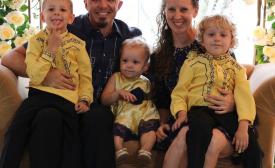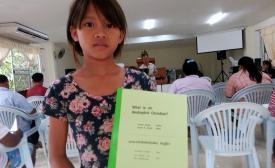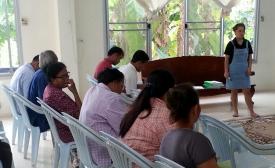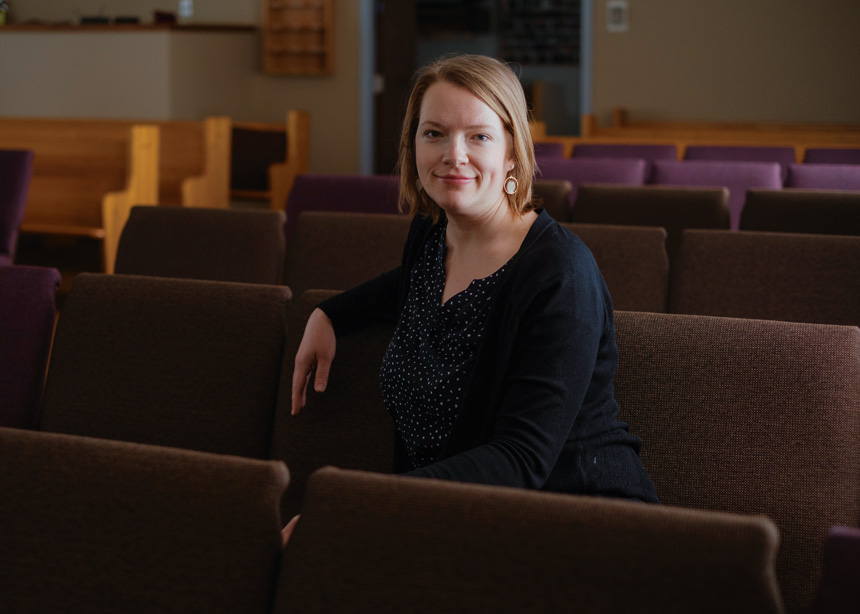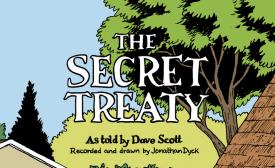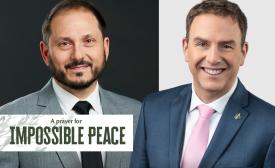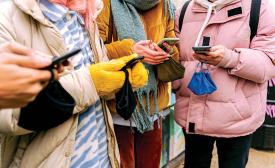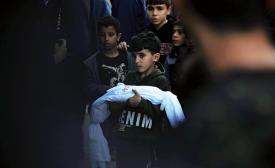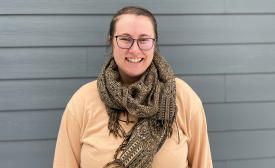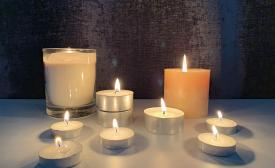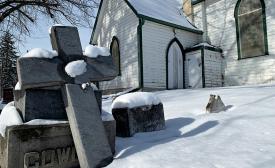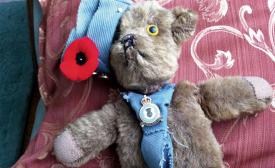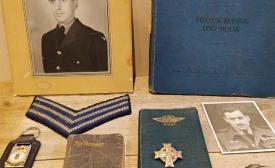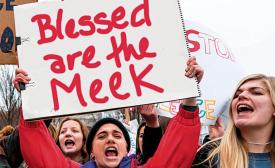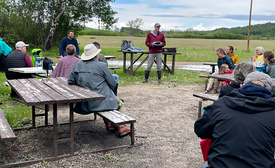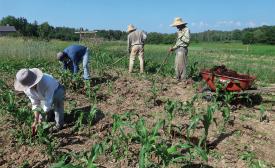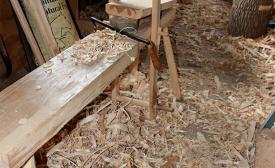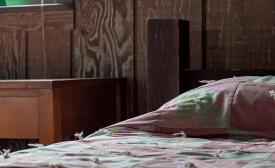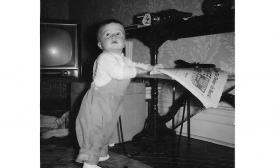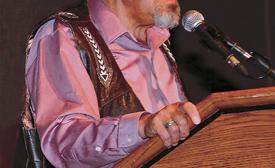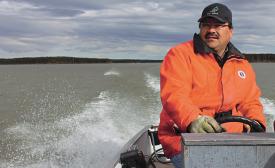Feature
A mother's 'yes'
The Secret Treaty
Breaking bread with broken people
The disciples were shocked when Jesus said, “One of you will betray me.” Judas’s story is told in different ways in the gospels, giving us some insight into how the disciples and gospel writers came to terms with the betrayal of Judas.
A prayer for impossible peace
The gulf appears impossible to bridge.
As bombs continue to fall onto Gaza and rockets somehow continue to fly out of Gaza, a conflict nearly as old as time and as entrenched as the Jordan River spirals to depths unthinkable. To listen to people on either side is to hear vastly different narratives about the same reality.
Jewish perspectives
Understanding absolutist views
On October 1, we launched our book, The Wall Between: What Jews and Palestinians Don’t Want to Know about Each Other, at the Charles Pachter Museum in Toronto. Guests included Jews, Palestinians and others who are interested in overcoming the enmity between the two sides that for so long have been in conflict. There was music and poetry.
Mideast dialogue programs fall short
“Deeply rooted in our Mennonite psyche is this idea that peacemaking is as simple as sitting across the table from someone and hearing their story,” says Joanna Hiebert Bergen, chair of the Mennonite Church Manitoba Palestine-Israel Network.
Lord, hear our prayer
To thine own self be true?
Baptism rates among teenagers and young adults who grew up going to church have plummeted. Why?
Scar of Bethlehem
What will Christmas be like in Bethlehem this year? What can we learn about the birth of Christ from those who live where he was born and where he lived?
Called to the work of the church
It might seem unlikely that young women would be drawn to church leadership and feel compelled to enter pastoral ministry. As young people, they are part of an underrepresented demographic in the church, one that is leaving organized religion in increasing numbers. As women, they have been barred for generations from leadership roles in the church and turned away from the pulpit.
As he lay dying
 There were nineteen beds in the hospice, that’s what I heard, most of them occupied, but I paid no attention to them.
There were nineteen beds in the hospice, that’s what I heard, most of them occupied, but I paid no attention to them.
Holy moments in the midst of grief
There’s one church service that Fran Giesbrecht makes a special point not to miss: Eternity Sunday.
Observed at his Winnipeg church on the last Sunday before Advent, Eternity Sunday provides opportunity for Giesbrecht and others at Fort Garry Mennonite Fellowship to commemorate members of their community who have died.
Memory carrier
“Sir,” said the man, “you and your family can be very proud of your son.”
The Beatitudes: Testing a biblical antidote to division
When conservative Christians in the southern U.S. were agitating to erect monuments with the 10 commandments on them in front of courthouses, I heard someone suggest that they put up the Beatitudes instead.
The idea stuck with me, as did the reaction of my Trump-loving, warm-hearted neighbour when I floated the idea by her. She loved it.
The gift of life, the question of death
Robert Bruinsma remembers the day his friend, Sam, told him he was going to die.
It was a few days before Christmas 2017, and Bruinsma was visiting Sam (not his real name) in the hospital. Sam told Bruinsma that his request for medical assistance in dying (MAID) had been approved and would be carried out on New Year’s Day.
Stepping overboard
Florence Driedger turns to look out the window before she replies to my question. “Well, we never know from one year to the next who and how many . . . whether we’ll still be functioning. We think we will be, but you never know.”
Humans and Humus
On a hundred hilly acres near Mildmay, Ontario, the Wiederkehr family is quietly pushing the limits of human energy, spiritual integrity and disconnection from the consumerist web. The following is the first in a series of bi-monthly dispatches from their family.
Rest and Restlessness
We asked the Canadian Mennonite community to reflect on rest and restlessness.
Broken to serve
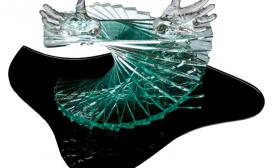
The glass sculpture titled, Imperative Change, is made from upcycled glass by Steinbach, Manitoba artist George Klassen. (Photo by George Klassen)
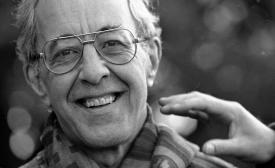
Henri Nouwen in 1996. (Photo by Kevin F. Dwyer, used by permission of the Henri J.M. Nouwen Archives at the University of St. Michael's College)
In my mid-30s, two decades after the last time my father beat me, and two years after he died, I broke glass twice in one week. Once, for the first time in my life, in anger.
In the current of wavering defiance
I want to know how to pray. It’s December 2021. Advent. A season of waiting. Everything is waiting. Waiting for the pandemic to be over. Waiting for our leaders to start acting like we’re in a climate emergency. Waiting for our hemisphere to tilt back into the light. We are hunkered down for our second COVID Christmas, separated from what we need most: each other.
Commerce, church and belonging
I was delivering a sermon on the story of Zacchaeus last October when I realized that when I talked about Zacchaeus, I was actually thinking about, and picturing, my father.
Though not short in stature, my father, like Zacchaeus, was a man whose occupation was often controversial in his community. My father, Milo Shantz, who died in 2009, was a businessman.
Dispatches from the front lines
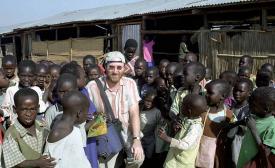
Ross W. Muir, with camera bag in tow, among a Grade 1 class at the Unyama IDP Camp in northern Uganda, 2004. (Photo by Michael Oruni)

Students look out from holes in the bamboo walls of their school at the Unyama Internally Displaced Persons Camp in northern Uganda, in 2004. (Photo by Ross W. Muir)
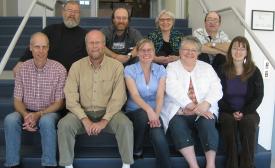
Members of the Meetinghouse editors and publishers group pose for a photo at Morrow Gospel Church, Winnipeg, during their 2009 meeting. Pictured from left to right, back row: Wally Kroeker, MEDA Marketplace; Ross W. Muir, Canadian Mennonite; Dora Dueck, MB Herald interim; and Terry Smith, The Messenger; and front row: Paul Schrag, Mennonite Weekly Review, at the time; Gordon Houser, The Mennonite; Rebecca Roman, The Messenger; Lil Goertzen, The Recorder; and Karla Braun, MB Herald, at the time. (Meetinghouse photo)
I’m basing the form of this final missive on the last book I read, Dispatches—a harrowing and sometimes hilarious memoir by Michael Herr, who covered the insanity of the Vietnam War for Esquire magazine during two years in the late 1960s. (How insane is it that Esquire thought it needed a war correspondent in the first place?)
An assumption of grace

A painting of Christopher Columbus planting his flag in the “New World,” by American artist Louis Prang. (L. Prang & Co., Boston, Public domain, via Wikimedia Commons)

Dave Scott poses with Brandon Burley, mayor of Morden, Man., left, and Cameron Friesen, MLA for Morden-Winkler, at a public event in Morden last summer. (Photo by Robyn Wiebe, courtesy of PembinaValleyOnline.com.)
After the Vatican’s recent repudiation of the Doctrine of Discovery, I spent two hours speaking with three Indigenous people about the 500-year-old church doctrine that is as much the bedrock of Canada as the Canadian Shield.

